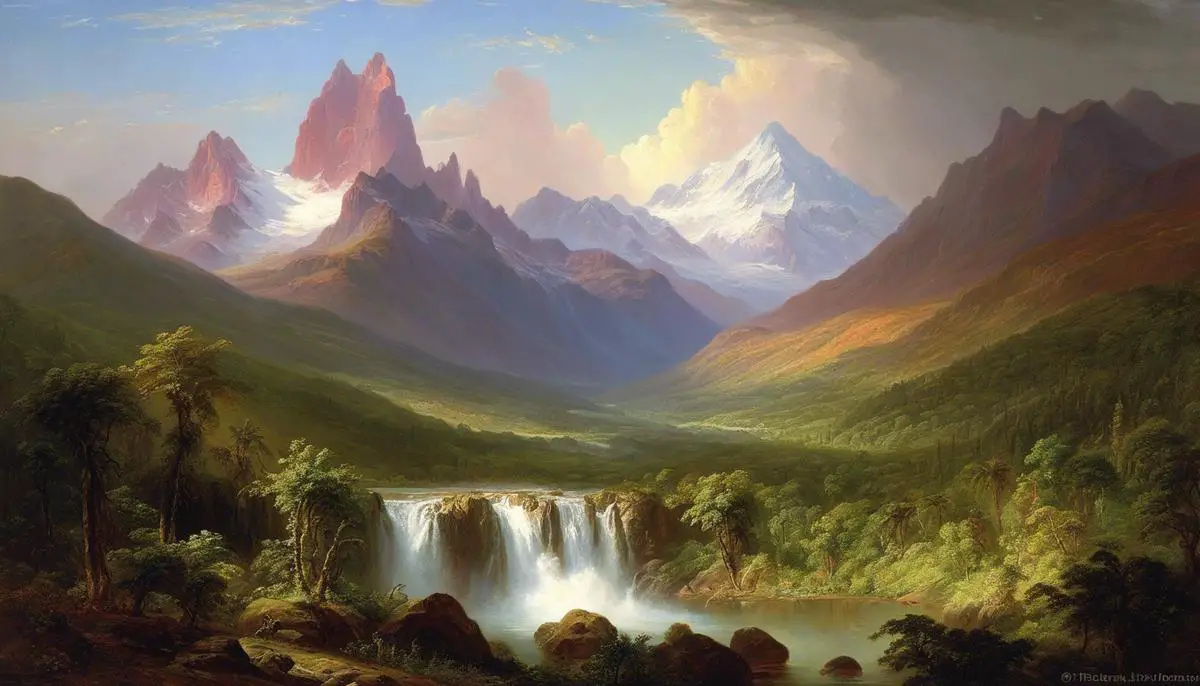Harkening back to the mid-19th century, a riveting period of monumental shifts and progressions, stirs the awe-inspiring story of one exceptional landscape artist, Frederic Edwin Church. Born amidst a world reverberating with the echoes of the Industrial Revolution and the spirited call of Manifest Destiny, Church sought solace in the embrace of nature’s grandeur, translating its majestic serenity onto his canvases. In this examination, we shall embark upon an intimate exploration of his life, artistic journey, and profound influence on the world of art, focusing our attention on his masterwork, ‘Heart of the Andes’. Transporting viewers to the heart of the South American landscape, this painting not only celebrates nature’s boundless beauty but also conveys a multitude of symbolic meanings and allegories.
Frederic Edwin Church: Life and Artistry
Immersed in a Palette of Nature: Exploring Frederic Edwin Church’s Sublime Artistry
Travel alongside us through the vivid, expansive canvases of the 19th-century American landscape painter, Frederic Edwin Church. As part of the second generation of Hudson River School painters, his art encapsulates a unique, profound understanding of nature, considered to be nature’s divine revealings.
Born on May 4, 1826, Church’s early life was steeped in art. As a protegé of Thomas Cole, the founder of the Hudson River School, he was trained in the tradition of American wilderness painting. It’s, however, his independent spirit and determination that churned out masterpieces celebrated to this day.
Frederic Edwin Church was not just a painter but also an adventurer and explorer. He travelled extensively, captivated by awe-inspiring landscapes, which ignited his artistic imagination. From the Arctic landscapes of Newfoundland to the jungles of South America, his extensive travels and meticulous observation of Mother Nature enriched his realism art style.
Contributing significantly to the art community, Church displayed a unique art style known for its luminous and dramatic effect. It veers slightly from the traditional Hudson River School style by introducing ‘luminism,’ where light and atmospheric conditions are captured with extensive detail.
His artwork gives spectators a panoramic view, creating a sense of immense depth and distance. They compel the viewers to pause and undergo a transcendental experience. This trait is remarkably visible in seminal works such as ‘Niagara’ and ‘The Heart of the Andes.’ Their stunningly rendered detail, punctuated with awe-inspiring panoramas, exemplify the sublime in Nature.
Church also had an indelible impact on nature conservation, particularly with his piece, ‘The Icebergs.’ At a time when a growing interest in the Arctic was unveiling itself, this painting shed light on the polar landscape’s fragile beauty — this artwork in particular played an influential role in igniting interest in that area’s conservation.
Yet, Church wasn’t simply an artist on the canvas; he crafted a living, breathing work of art in his home as well. Named Olana, after a fortress-treasure house in ancient Persia, the home is a unique fusion of Victorian architectural elements and Middle-Eastern decorative motifs, very much an embodiment of his artistic spirit and global exposure. Today, Olana stands as a national historic site, treasuring Church’s interpretations of the world and its scenic beauty.
It’s clear then that Frederic Edwin Church was not restricted to merely the strokes of his paintbrush. His artistic prowess was a vibrant blend of exploration, observation, and imagination. His contribution to the art field mirrors his sweeping landscapes, vast, detailed, and ceaselessly intriguing – a remarkable testament to Mother Nature’s grandeur. His legacy, very much like his artwork, invites us all to gaze into the world’s sublime beauty and garner a deeper respect for it. Through the filter of his eccentric art style, we perceive a profound understanding of how art, nature, and humanity entwine in a harmonious design.

Historical Background of Heart of the Andes
Our journey into the heart of art history continues with the exploration of Frederic Edwin Church’s monumental masterpiece, Heart of the Andes. Created in 1859, this painting is as grand as the scenery it captures, standing over 5 feet tall and 10 feet long. While enveloped in the splendour of Church’s artistry, one can’t help but ponder the historical context that inspired such a striking depiction of the Andean landscape.
To offer some perspective on this historical rerun, the mid-19th century was marked by a burgeoning fascination with new frontiers and uncharted territories, fuelled chiefly by the advent of international travel and exploration. This epoch coincided with the emergence of the Romanticism movement in art, with artists eager to capture the transcendent beauty and sublimity of nature. Church, an epitome of this movement, reflects the spirit of his era in Heart of the Andes, merging the spectacular allure of the South American landscape with his inimitable artistic flair.
Ironically, Church’s chosen scene was far from a tranquil paradise. During the 19th century, Latin America was at the fulcrum of violent upheavals and wars for independence. From this standpoint, the unblemished beauty in Heart of the Andes amounts to a marked contrast with reality. Scholars speculate that Church’s idealised interpretation was intentional, driven by his wish to project a vision of harmony amid the turmoil.
The painting’s creation followed the demise of Church’s mentor, Thomas Cole, whose core philosophy was deeply rooted in the sublime nature of landscapes. Church’s homage to his mentor is manifest in Heart of the Andes – an intricate compilation of the elements found in Cole’s bodies of work, relocated to an exotic South American setting.
A noteworthy aspect of Heart of the Andes is the influence of the Hudson River School. This art movement shared a unique affinity with nature, revering it as a manifestation of divine beauty rather than a simple resource for human use—the grandeur of the Andes and the exquisitely detailed flora and fauna reflect this ethos precisely.
In conclusion, Heart of the Andes exemplifies Church’s observations of the era, coloured by his creative lens. He masterfully distils the cultural zeitgeist of the 19th century into a sublime panorama, offering a profound statement of his unique artistic perspective. Each viewing unfurls new layers of Church’s ingenious narrative, a testament to his enduring place in history as a painter of epochal works of art.

In-depth Analysis of Heart of the Andes
Delving Down into the Heart of the Andes
Frederic Edwin Church’s vibrant, panoramic masterpiece, the Heart of the Andes, gathers the power of nature and its divine beauty, telling a complex story that surpasses the painted canvas. It’s far beyond just an artistic appreciation of nature; it’s a symphony that reverberates with intricate elements full of meanings and symbolism.
The darkling expanse of vegetation, crystal-clear water, and the celestial veil of the atmosphere shape the visual allure of the Heart of the Andes. Each element carries its significance, contributing to the composite ideological body of the artwork.
Observe the towering, majestic peaks – they assert dominance over the landscape, embodying the Andes’ raw, rugged character. While they symbolise the sublime beauty of nature, metaphorically, they represent the spirit of adventure, the challenges faced and surmounted by Church during his South American voyages.
Then, there is the tropical verdant splendour that swathes most of the scenery. It’s not mere decoration but epitomises the fertile lands of Ecuador and Colombia that Church explored during his expedition in 1853. The vegetation, dense and lush, conjures a sense of abundance but also stimulates an empathetic understanding of the fragility of nature.
Water often takes on symbolic roles in artwork, and it’s no exception in the Heart of the Andes. The serenely flowing river that meanders through the landscape symbolises life, serving as a testament to the power of Mother Nature as a life-giver. Church showcases an enchanting depiction of water in motion, drawing viewers towards its effervescent vitality.
The sky, with its ethereal azure and drifting clouds, signifies the airiness of hope and magnificence of divine entities. It asserts an emotional tonality on the overall portrait, lending a spiritual depth that prompts us humans to aspire for loftier planes of existence.
The seemingly mundane artefacts like the cross and the rustic dwellings nestled amongst the lush greenery bear their symbolic import in the Heart of the Andes. The cross referencing Church’s Christian faith gives a divine significance to the landscape and resonates with the tranquillity associated with holy spaces. Similarly, the huts represent human habitation in harmony with nature, a lifestyle romanticised during Church’s era.
From this detailed analysis of component elements, Heart of the Andes emerges as a triumph of Romantic art, capturing the splendour and fragility of Mother Earth. It is rich with symbolism, evoking a profound dialogue on the relationship between humans, nature, and spirituality. Frederick Edwin Church’s meticulous eye for detail not only showcases his artistic flair but also his understanding of nature’s inexplicable synergy, resulting in a timeless masterpiece that continues to inspire and provoke thoughts to this day.
Much like a poem, it seems the Heart of the Andes is not read at once but requires the observer to explore, perceive, and resonate with every yet unfolding element until the entire panorama is understood and marvelled at its fullest. It is not a work of a moment, but a continual discovery, a journey through the heart of nature, through the heart of the Andes.

The Impact and Legacy of Heart of the Andes
Unveiling the ‘Heart of the Andes’: A Journey into the Landscaped Dream
Walking seat-to-seat in a meticulously designed hall sat an audience enthralled, staring fervently at a captivating canvas hanging alone on the gallery wall. The canvas bore the masterpiece ‘Heart of the Andes’ by Frederic Edwin Church, encased in a window-like frame, as if capturing a stunning view of the world beyond. It was more than just a painting; it was Church’s genius brought to life, materialising a paradise where all elements of nature danced together harmoniously.
The Heart of the Andes’ is classically Church, exuding sublime energy and an extraordinary sense of realism. The riveting tranquillity evoked by the dramatically portrayed Andean landscape and the minutiae lent both to its spatial grandeur and emotional depth, were the painting’s pivotal contributions to the realm of landscape painting.
The towering peaks draped with greenery, and the silvery thread of water coursing through, were not merely a faithful replication of landscape elements, but symbolic narrative features. The mountains were the symbols of majesty and breathtaking grandeur; their overwhelming presence echoing the sublime in art that dwarfed human figures, further exemplifying the Romantic art theme.
Church focused on the lush vegetation, giving a nod to the intricate details of the flora found on his expeditions in the heart of the Andes. The dense foliage could be an emblematic representation of abundance and life’s fragility, layered subtly into the visual narration.
Water, another key element in the artwork, touched on the theme of life’s relentless fluidity and transformation. Whether depicted as a raging waterfall or a serene lake, it mirrored the unbridled power and tranquillity of nature in harmony.
Possessing a celestial character of its own was the sky. Undulating waves of clouds stretched across it, akin to a spiritual canvas graced by divine hands, heightening the spiritual essence of the piece. This carefully crafted sky was a powerful instrument in illustrating the celestial depth and the mesmerising breadth of the landscape.
In ‘Heart of the Andes’, Church also employed human symbolism to augment the painting’s narrative. The unobtrusive sight of a cross and rustic dwellings nestling in the bosom of nature waved a flag of coexistence of human life with the divine beauty of nature. It strengthened the Romantic ideal of humanity’s profound connection within the ambience of the sacred natural world.
This unforgettable piece’s legacy lies in its distinctive merger of landscapes and symbolic narratives, drawing spectators into an eloquent ode to nature’s wonders. Its relevance continues undiminished, being both an aesthetic delight and a dialogue between the brush and the audience. The ‘Heart of the Andes’ dost not just hang on a gallery wall; it stands as a landmark bridging the humility of human spirit to the grandeur of Mother Nature. As we delve again into the intricate details of the painting, we undertake a fresh journey, unpicking the layers of Church’s genius and making new discoverings in the ‘Heart of the Andes’.

The ripple effects of Church’s ‘Heart of the Andes’ continue to reverberate, its resounding echoes influencing generations of artists and fostering a sense of environmental consciousness that remains remarkably relevant. The painting, with its majestic landscapes, draws one into the wide vastness and intricate details of the natural world, prompting a sense of awe and an inherent need to protect these extraordinary landscapes. The beauty captured so eloquently in ‘Heart of the Andes’ compels us to keep revisiting it, to keep questioning and exploring its depths. Such is the nature of truly impactful art — it invites us to engage, ponder, and interpret, ultimately stirring within us a symphony of emotions that transcend space and time and forever rendering the legacy of Frederic Edwin Church indelible.
Recommend0 recommendationsPublished in Uncategorized







Responses